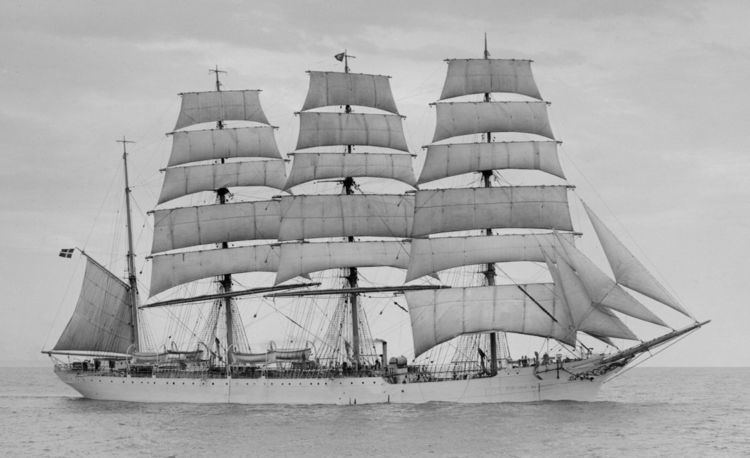Name Viking Launched 1 December 1906 | Cost DKK 591,000 Maiden voyage 19 July 1907 | |
 | ||
Owner Den Danske Handelsflaadens Skoleskib for Befalningsmænd AS, Copenhagen (1906-1915)De Forenede Dampskibs AS, Copenhagen (1915-1929)Gustaf Erikson, Mariehamn, Finland (1929-1950)City of Gothenburg, Sweden (1950-1998)ESS Hotell AB, Gothenburg (2013-present) Builder Burmeister & Wain, Copenhagen, Denmark | ||
Viking (also known by the ship type as a prefix, Barken Viking) is a four-masted steel barque, built in 1906 by Burmeister & Wain in Copenhagen, Denmark. She is reported to be the biggest sailing ship ever built in Scandinavia.
Contents
Ship history
Viking was originally built as a sail training ship for the rapidly growing Danish merchant fleet. At that time, seaworthiness and cargo capacity were given top priority. One day in July 1909, while carrying a full cargo of wheat from Australia, Captain Niels Clausen recorded a speed record in the ship's log: 15.5 knots (28.7 km/h; 17.8 mph).
On 25 February 1917, she was sighted and boarded by the German commerce raider Seeadler. Unusually, the Germans then allowed her to proceed because being Danish, she was a neutral ship. This was something of a lucky escape, because within weeks Germany would return to unrestricted marine warfare, a tactic that would have meant sinking her.
In 1929 she was registered under the Finnish flag, and joined the Åland-based Erikson fleet of tall ships. She was part of Erikson's fleet until 1950. She was about to be scrapped in the late 1940s, but was eventually saved by the Swedish government in 1950 and moored in Gothenburg. A suspension bridge built in the late 1960s has effectively locked the ship in, since the masts are taller than the bridge. It is unlikely she ever will sail the open seas again.
She participated in several of the Great Grain Races from Victoria, Australia to Falmouth, Cornwall. Barken Viking won the Grain Race of 1948. David James was an apprentice on her voyage around the world in 1937-38, which is described in his biography.
There are only ten four-masted barques and one four-masted full-rigged ship (the Falls of Clyde) in existence, and only five of these still sail (Sedov, Kruzenshtern, Sea Cloud I, Nippon Maru II, Kaiwo Maru II). A few more are still afloat and berthed in various harbors (Peking (New York City), Moshulu (Philadelphia), Passat (Lübeck, Germany), Pommern (Mariehamn, Finland), Nippon Maru (Yokohama, Japan), and Viking).
Viking came to Gothenburg in Sweden permanently in 1950, as a home for various shipping organizations, and later became a school of seamanship. Today she is moored at Lilla Bommen as hotel "Barken Viking". The owner is ESS Hotell AB.
Finnish artist Lena Ringbom-Lindén, one of few females on board a ship at that time, sailed on Viking on one of her voyages to Australia. She wrote of her experience in two books, Flicka på skepp ("Girl on Ship") and Skeppet och Lena ("Lena and The Ship").
Cargoes
Viking's cargos:
